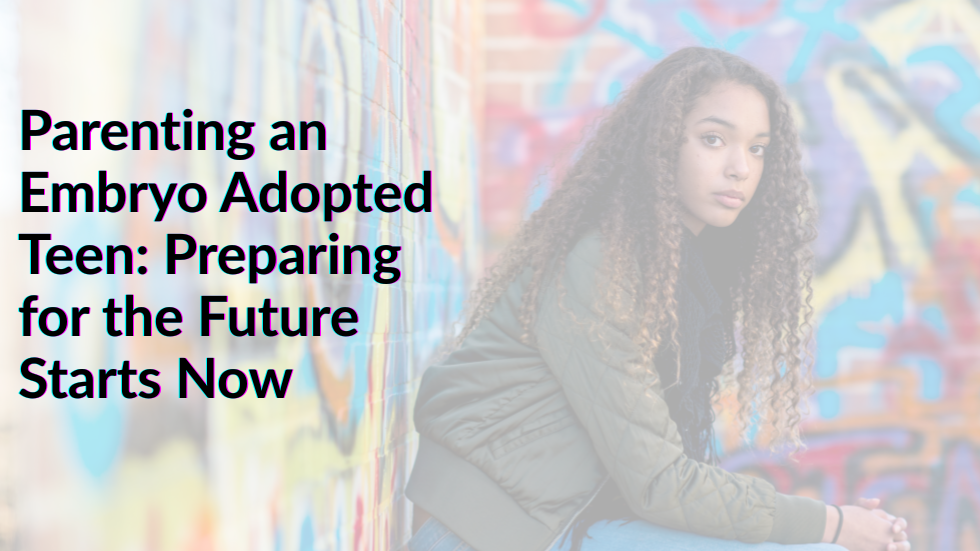Parenting a teenager may feel light-years away—especially if you are just beginning the embryo adoption process, preparing for your first transfer, or settling in with a newborn. However, no matter where you are on your parenting journey, your child will grow up faster than you think—and that includes growing into adolescence. It is never too early to begin laying the foundation for how you will parent them as teens, especially when adoption is part of their story.
Why is parenting an adopted teenager different?
Whether your child joined your family through traditional adoption, foster care, donor conception, or embryo adoption, they come with a unique reality: a difference between their biology (genetic origins) and their biography (life story with you). Bridging this gap with openness and honesty can strengthen your child’s identity and your parent-child bond.
In today’s world of social media, internet search engines, and direct-to-consumer DNA kits, the truth will come out—whether it comes from you or not. Telling your child their story early and often helps ensure they hear it from the people they trust most: You.
Here are eight way to prepare now for parenting your embryo adopted teen through openness:
1. Want trust? Give truth.
If you want your child’s trust as a teenager, build it from the start with truth. Concealing their origins—even with good intentions—can lead to feelings of betrayal and confusion later on.
As one embryo adoption mom shared:
“We were counseled early to be open about our story. Because of that, I have a deep trust with my daughter. You can’t build closeness on a lie.”
2. Your child owns the story.
Once your child enters the picture, the story of how they came to be is no longer just your story—it is theirs too. Share the full truth with your child in an age-appropriate way, especially before they reach adolescence. This does not mean disclosing every detail at once, but developing a plan to hand over the whole story over time.
3. Acknowledge your own hesitations.
If openness feels hard, ask yourself why. Is it grief from infertility? A fear of losing connection due to lack of genetic ties? Not knowing what to say? These are real and valid struggles—and they are yours to work through, ideally before your child begins asking deeper questions. Therapy, support groups, or coaching from organizations like Creating a Family or Donor Conceived Community can help you move toward openness with confidence.
4. Privacy is not secrecy.
Being open with your child does not mean sharing his or her story with everyone else. Teach your child that their story is personal and sacred—something to share only when, how, and with whom they choose.
Ask yourself:
- Does this person need to know?
- Why do I want to share this?
- Could sharing it cause harm or discomfort?
5. Timing is everything.
Tailor what you share to your child’s age and maturity. Revisit the conversation regularly. A five-year-old’s questions will not be the same as a fifteen-year-old’s. Stay flexible and open as their understanding deepens and evolves.
6. Master the “Dance.”
Conversations about identity, origin, and adoption are rarely one-and-done. Think of it as a dance—you lead sometimes, they lead others. Be ready to follow your teen’s cues, answer their questions honestly, and gently open the door with “pebble” comments: small, casual conversation starters that invite deeper discussion.
7. Make openness your normal.
The more you normalize your child’s story, the less taboo it will feel—especially during the socially sensitive teenage years. Let openness be a natural, integrated part of your family culture. If it is normal for you, it will become normal for them.
8. What if your adoption started anonymously?
Even if you began your journey with anonymous donation or adoption, it is never too late to practice openness. Contact with the donor or placing family is helpful, but not essential. What matters most is your willingness to be honest with your child about their origin, however limited the details may be.
Adolescence brings plenty of challenges and changes—but if you start building trust and openness now, you will have a strong, honest foundation to grow from.
Your child’s story is something to celebrate, not conceal. Walk with them in it, hand-in-hand, and every step of the way. To learn more about embryo donation and adoption, visit EmbryoAdoption.org.
Learn More & Prepare for the Future
Video: Normalizing Embryo Adoption for Your Child:
Reading List:
- Telling the Truth to Your Adopted or Donor Conceived Child by Lois Melina
- Adoption Parenting by Jean MacLeod and Sheena Macrae
- The Whole Life Adoption Book by Jayne Schooler and Thomas Atwood
To learn more about embryo donation and adoption, visit EmbryoAdoption.org.


Recent Comments